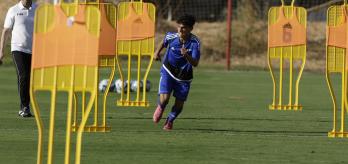The sessions and drills covered in this series are not intended to be a training prescription, rather they are for practitioners to select individual drills or entire sessions to fit their overall training plans for players in their care.
The scope of this series covers the period from recommencing ball work to returning to full training with the rest of the team. The content is divided into three phases and is applicable to players recovering from both short-term injuries (less than two weeks) and longer lay-offs (several months). Following short-term injuries, these sessions or drills might be used only once as part of a fast-tracked return to action; when longer periods of preparation are required, they are likely to form a foundational core of work to be repeated over multiple training sessions.

Training perspective
To implement the drills in this series, a minimum of three participants are required, with one working player assisted by two ball-serving players. Most clubs should be able to facilitate this, either with multiple players recovering from injury working together or by including a combination of youth players and/or coaches to assist the recovering player(s).
This approach is essential when preparing players to return from injury, as it moves away from the traditional one-player, one-coach scenarios in which the exercises bear little relevance to footballing functions and are more like obstacle courses with very few touches of the ball used as a reward. The foundation of football is receiving the ball from one player and giving it to another. Using a minimum of three players plus one coach or server and a little creativity provides the opportunity of great functionality to the drills developed for this series.
While recognising that training without the ball may continue after the ball has been reintroduced, footballing functionality is the primary focus of this series, specifically technical conditioning drills that help to prepare a player both technically and physically.

Training phases
The series is divided into three phases, with two or more sessions developed for each phase relating directly to the training progressions required towards a player`s return to team training.
Phase 1
Functional coordination
- Reintroduction to technical training with the ball
- Individual technique and coordination with and without the ball
- Collective technique and coordination between a unit of players
Phase 2
Functional endurance
- Technical conditioning (extensive): Near continuous workloads with short recovery periods interspersed within the technical interaction
- Attacking technical conditioning (intensive): High-intensity interval workloads with an emphasis on attacking play
- Defensive technical conditioning (intensive): High-intensity interval workloads with an emphasis on defensive play and transitions from defence to attack
Phase 3
Functional speed
- Technical speed focusing on acceleration and high-speed runs
- Technical speed and agility focusing on acceleration and deceleration

Workload training metrics and training matrix
A metrics table of training variables is provided for every session. A model training matrix is also provided at the end of each phase, suggesting when to implement certain drills. The matrix should be used for injury recovery periods of between two weeks and one month. For longer periods, the one-month matrix can be extrapolated (NB: the training matrix contains no training content without the ball).

















